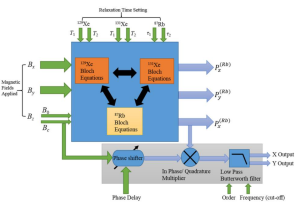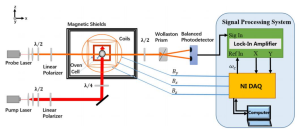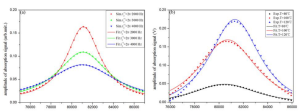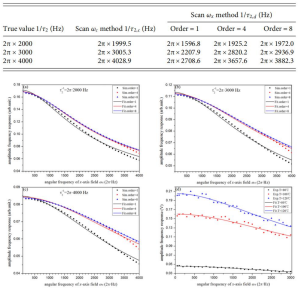Experiment title: Interference-Free Measurement of Transverse Relaxation Time in an Alkali Metal Magnetometer in a NMR Oscillator.
Research direction: Quantum precision measurement.
Experiment content:
The transverse relaxation time τ2 of the embedded alkali metal magnetometer is an important parameter to characterize the performance and working state of the NMR oscillator system.
The method for measuring the transverse relaxation time τ2 proposed in this experiment is to apply a sweeping magnetic field in the x-axis direction, then measure the amplitude-frequency response curve of the magnetometer in the x-axis direction, and finally obtain τ2 from the 3dB bandwidth of the amplitude-frequency response curve.
Experiments give a detailed and rigorous theoretical derivation based on the perturbation-iterative method to demonstrate the rationality of this measurement method. Then, simulation experiments and practical experiments are carried out, and the results can verify the effectiveness and high accuracy of this measurement method.

Since all sampling frequency points in the frequency sweep range are far away from the NMR frequencies of 129Xe and 131Xe, any influence on the nuclear spins can be avoided, so this measurement method can provide a non-disturbing way to measure τ2 to Aids in monitoring the status of an NMR oscillator system during its normal operating conditions.
Test purpose: The atomic gas chamber of the experimental system needs to be heated by a heating plate, and the amplified current output by the power amplifier can drive the heating plate.
Test equipment: heating plate, heat preservation device, Saluki SLA-HVP-225 high voltage power amplifier.
Experiment procedure:
Use the temperature control program and data acquisition card equipment to output a high-frequency (hundreds of KHz) high-precision heating voltage control signal of appropriate amplitude, input it to the power amplifier, and adjust the output current parameter of the amplifier to 1 A in the constant current working mode Left and right, and then the power amplifier amplifies the input electrical signal, and the output current of the power amplifier is connected to the heating plates connected in series, and the heating plates are evenly distributed in the heat preservation device to heat the atomic gas chamber at a constant temperature.

Test results:
The temperature stability of the atomic gas cell heating can reach ±0.002°C, and the heating temperature can be at least as high as 130°C.


Saluki SLA-HVP-225 high voltage power amplifier performance in this experiment:
The high-precision output current of the power amplifier is passed to the heater in series to drive the heater.



